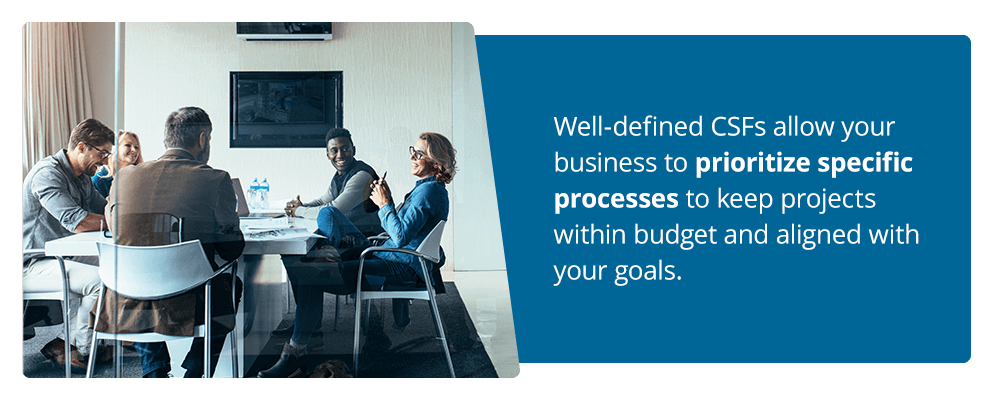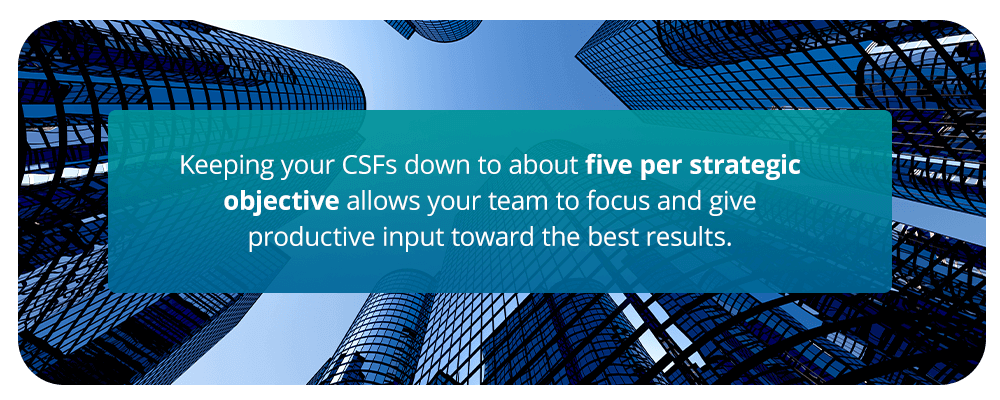For businesses to succeed, they must start with an understanding of what success means for them. Leaders who want to achieve, innovate and reach new heights need a list of pivotal successes their team needs to meet.
The critical success factors of a business are crucial to its success. Without them, it won’t be able to quantify its achievements and setbacks. These factors focus your team and align tasks toward achieving your goals. Each critical success factor lays a solid foundation for future business development.
In This Article
What Is a Critical Success Factor?
If you define the elements of your business or project that are vital to your success, you can do so with critical success factors (CSFs). Your business must achieve these high-level goals to meet your strategic objectives. Your CSFs connect with your organization’s business strategy — you can execute them throughout your organization, across programs and projects.
CSFs give your business strategy meaningful value. Rather than measuring the success of your organization or projects, CSFs provide systems through which your company can succeed. You can establish CSFs to augment your strategies throughout daily operations and guide your business toward achieving its objectives.

Types of Critical Success Factors
Critical success factors fall into four key categories:
1. Industry Factors
Industry critical success factors result from specific trends and characteristics unique to your industry and allow you to maintain a competitive edge within it. Some examples of industry CSFs include the following:
-
- Improved customer service
-
- Innovation
-
- Green alternatives
2. Environmental Factors
Consider the environment in which your business operates. While you have little control over the economy, technological advancements or the business climate, they’re still valuable considerations in determining critical success factors.
Knowing what issues could impact you is crucial to preventing unnecessary risks through strategic planning. A thorough understanding of environmental factors allows you to prepare for problems in the future. Examples of environmental critical success factors include the following:
-
- Economic downturn
-
- A change in policy that directly impacts your business
-
- Infrastructural changes like an increase in electricity prices
3. Competitive Factors
Competitive factors stem from your customers’ view of your business relative to your competitors. Your goals will relate to either maintaining or improving your position and your critical success factors determine your actions to achieve those goals. Since other companies in your industry will be doing the same, competitive critical success factors are subject to more immediate influence.
Examples of competitive critical success factors include the following:
-
- If you want to break into a new country, you may focus on a CSF like understanding cultural differences.
-
- Building your appeal to a particular customer demographic could be a factor in expanding into an audience a competitor has cornered.
4. Temporal Factors
Like internal organizational changes, temporal factors are limited, short-lived factors that may affect your business. Identifying these factors allows you to counteract and overcome them effectively. Staying ahead of temporal factors can maintain your operations.
Examples of temporal critical success factors include the following:
-
- A rapid expansion
-
- Opening new offices that require hiring new staff to complement your existing team
-
- Unexpected changes to your business model, like creating an online store during the COVID-19 pandemic
Why Do Critical Success Factors Matter?
Businesses need to set actionable goals to succeed. With critical success factors to augment your goals, you can monitor the path your business takes to achieve them. Defining CSFs is like choosing a route on a map — you want to find the best and fastest way to reach your goals.
CSFs help you build your business strategy. If your goal is to increase online sales, the critical success factor defines what you need to achieve this goal. With a record of the steps you took to reach it, you can identify successes and opportunities for improvement, making it easier to replicate the achievements or implement changes.
Well-defined CSFs allow your business to prioritize specific processes to keep projects within budget and aligned with your goals. They are an excellent tool for streamlining strategic project management so your business can consistently achieve better results.

Critical Success Factors vs. Key Performance Indicators
While critical success factors and key performance indicators (KPIs) may seem the same at first glance, there are several key differences between the two:
-
- Intentions: Businesses use CSFs to guide success beforehand, using them to streamline operational processes and increase sales. KPIs measure business success, tracking how well a business meets its objectives after the fact. CSFs will augment your strategy, while KPIs will give you an idea of how well your strategy is performing.
-
- Formats: CSFs take a qualitative approach, using words and phrases to outline what a business can do to achieve its goals. KPIs are quantitative, assessing business performance with numerical evaluations like percentages and statistics. For example, a KPI could be a 15% increase in online sales.
-
- Places in strategic goal structure: CSFs and KPIs are potent tools businesses can use throughout their goals. For example, you may want to improve employee engagement. You can add specificity to this goal with a CSF of providing goal-related meetings. A KPI would track how many people attend these meetings and quantify employee feedback.
Critical Success Factor Examples
Deciding on the CSFs best suited to your business can be challenging. Companies have many goals that vary within teams and projects. Some common critical success factors across industries include the following:
-
- Improve social media engagement.
-
- Increase the number of new clients each month.
-
- Maintain a ‘no accident’ status in a warehouse.
-
- Develop and maintain successful relationships with local suppliers.
-
- Deliver customer-focused training to all staff.
-
- Develop new leadership strategies.
-
- Enhance the company culture.
-
- Improve the quality of online content.
-
- Advance applications to improve staff efficiency.
The list can be endless. Just as your business goals are often unique, your CSFs will be the same. Remember, while a critical success factor is tied to your goal and provides mechanisms to achieve it, CSFs are not goals themselves. Let’s have a look at some examples of how they differ:
-
- If your goal is to attract new customers by adding products to your range, a CSF could be to create relationships with local suppliers so you can source locally.
-
- If your goal is to expand your offices, your CSFs could be securing the finance for the expansion and managing the disruptions during construction.
When Should You Define Your Critical Success Factors?
The planning phase is the best time for critical success factor definition. Since CSFs are linked to your goals, it makes sense to plan the two simultaneously. Doing so aligns them and clearly shows your team’s steps to accomplish critical tasks.
The number of CSFs you define for each goal will depend on the size and scope of the project. Generally, it’s best to try sticking to around five CSFs per goal. If you include too many, it can become challenging to integrate them into your operations and track their progress.
How to Develop and Identify Critical Success Factors
If you’re not sure where to start, you can follow these five simple steps to set your first CSFs:
1. Define Your Mission, Values and Strategy
If you haven’t already, it’s time to write your mission and vision statement. These statements are the building blocks that make up your business — your mission, values and strategy. Be sure to consider the following:
-
- What your company should prioritize
-
- How your goals align with your mission and values
-
- Any challenges you’re facing
Take environmental and strategic factors into account and identify your current strengths and weaknesses. Determine political, economic, socio-economic and technological factors that may affect your strategy and CSFs. Follow up with an analysis of your internal strengths, weaknesses, opportunities and threats.
Identifying all the factors that influence the formulation of your CSFs will give you an accurate view of where you need to focus.
2. Identify Your Strategic Goals and Create a CSF Shortlist
What are your company’s key strategic goals? In other words, where would you like to go? Clarify the strategic objectives linked to your mission and values.
Once you know where you want your business to go, ask yourself one more question — how will you get there? It may seem like an obvious question, but knowing the ‘how’ is even more important than the ‘where.’ What will your business need to do to achieve your strategic objectives? Write a list of answers to this question, covering all the steps you need to take. Just like that, you have a CSF shortlist.
One of your strategic goals may be higher staff retention. Your CSF shortlist could look like the following:
-
- Create ongoing learning initiatives and provide quality training.
-
- Improve intra-departmental communication.
-
- Invest in staff happiness with incentive programs.
-
- Provide employees with online chatrooms and forums to foster better communication.
-
- Create a peer reward system where employees can draw attention to one another’s achievements.
Keeping your CSFs down to about five per strategic objective allows your team to focus and give productive input toward the best results.

3. Assess Your CSF Shortlist and Choose the Top Contenders
Take a look at your shortlist and start evaluating each entry. Remove all but the most essential to your goal’s success.
Keep an eye out for CSFs that influence or depend on one another. Looking at the critical success factor example list above, you’ll see that “Improve inter-departmental communication” and “Provide employees with online chatrooms to foster better communication” are linked. In this case, you could remove the first point, as the second provides a concrete method of achieving it.
A few moments to establish your priorities could save your team from wasting effort and focus their attention on the most critical areas. As you examine your list, you may find that some of your CSFs aren’t priorities at this stage. You can note them for later strategy changes as they may become applicable.
4. Share Your CSFs With the Right People
Once you’ve decided on your CSFs, it’s time to consider who could help your business achieve them. Consider what activities each CSF will require and which department or person will be accountable. Your CSFs may even create new roles within your organization!
Communicating your CSFs to stakeholders and others throughout your organization is crucial. Be clear in your communications about why you chose these CSFs, why you need to achieve them and the methods you hope to use. Your team can provide you with valuable feedback and may have some ideas of their own. You can refine your CSFs together, so they fit seamlessly into the workflow of your business. With input from team leaders, you can maximize the success of your initiatives.
5. Measure Your CSF Efficacy and Progress
CSFs are qualitative, so measuring their success can be challenging. With your stakeholders aware of your CSFs, you can ask different departments to help you find a way to measure them. Assigning someone to watch your CSF progress and make them accountable might be valuable.
Consider attaching a KPI to each relevant critical success factor. You’ll be able to get a more accurate measure of your CSFs’ performance and identify any speedbumps in your path. If you can identify bottlenecks, you can address them.
How AchieveIt Can Help Your Organization Succeed
AchieveIt provides organizations with integrated plan management. We help you with all your strategic planning, from plan creation and performance assessments to plan and progress management. With AchieveIt, you get an integrated view of your strategic initiatives in one place. If you need input on achieving your goals, you can turn to our execution experts to help make your goals more actionable.

AchieveIt lets you bridge the gap between strategy and execution in the following ways:
-
- Align, integrate and execute strategic plans: AchieveIt is a flexible platform capable of managing multiple strategic projects across your organization. With our systems in place, alignment is a requirement and processes are the focus.
-
- Automate progress updates: AchieveIt focuses on the end user and makes the update process easy for team members to adopt.
-
- Drive meetings with context: Communication is crucial for strategic planning and historical context adds another layer to your communications. You can drive meetings with filterable reports that allow you and your stakeholders to focus on your most important initiatives with a historical context at the click of a finger.
-
- Combine qualitative and quantitative insights: AchiveIt combines numerical data with context and supporting initiatives, so your team can understand how initiatives are performing. They can also understand why they perform specific tasks and what work is necessary to optimize results.
-
- Drive insights and decisions: You can drive your insights and decisions with AchieveIt’s customizable reports and dashboards across one or multiple plans. Automated report distribution keeps stakeholders up to date with initiatives.
-
- Involve teams across your organization: Strategic initiatives work best when everyone works together. AchiveIt provides in-depth onsite training, so everyone is on the same page.
-
- Optimize your plans: AchieveIt grants you access to professional execution experts with critical insights on achieving your strategic goals. Your execution experts are your second set of eyes, helping you streamline your plans for the best results.
-
- Measure your ROI: AchieveIt will provide detailed analyses of your success in regular business reviews.
Let’s Actually Do This
AchieveIt is a tool that can change your business space, focusing on bridging the gap between strategic planning and execution with innovative integrated plan management. To learn more about how to connect, manage and execute key plans and initiatives with AchieveIt, request a demo and see how we can help make your goals actionable.



